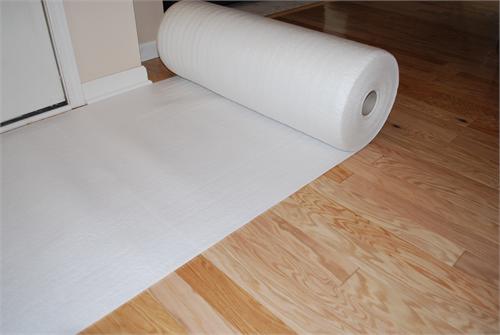When installing laminate flooring, you want to make sure that everything fits perfectly and that the end result is practical, comfortable and fully functional. While it can be tempting to simply lay the flooring down over whatever surface is underneath, this isn’t generally a good idea. But what should you use instead; what goes underneath laminate flooring?
Before laying down your laminate flooring planks, you will need to use underlayment which is a soft pad onto which the boards are placed. Sometimes, this underlayment will already be attached to the bottom of the planks to make life easier but other times you will have to lay it yourself before the boards.
In any case, using underlayment is one of the most important parts of installing laminate flooring as it provides an even surface and will help the planks to connect better. Moreover, with underlayment in place, the flooring will feel much softer and more comfortable to walk on.
What’s The Point In Underlayment?
The importance of underlayment below your laminate floor is massive and it cannot be overstated. While many people feel that this is ‘just another step’, it’s one that is definitely worth taking. Without it, the floor will be unstable and eventually become unusable.
Using underlayment will do two main things to ensure that your laminate flooring installation is successful. Primarily, it will remove any minor flaws in the subfloor which could cause the overall finish to be uneven. Secondly, underlayment will help to reduce noise. But of course, this product will also make the floor more comfortable when you walk on it which is essential, especially in a residential setting.
Which Type Of Underlayment Do I Need?
If learning that underlayment is so important has come as something of a surprise to you then you may be even more surprised to learn that you have several options when it comes to the type of underlayment you need. It’s important to assess the subfloor as this will tell you a lot about the most suitable option. While there are many different types of subfloor, most commonly they will be made from either wood or cement.
For wooden subfloors you will be able to use anything between a standard and premium underlayment product. It all depends on the sturdiness of the pre existing wood but if you notice that it is slightly uneven or creaky then you may need something of a little higher quality that will better reduce noise and provide additional cushioning.
Where cement floors are concerned, it’s important to use a vapour underlayment as this will prevent any moisture from seeping through and damaging your wooden planks. Typically, this type of underlayment is also used in installations that are below the ground level where moisture levels are more difficult to control.
What About Pre Attached Underlayment?
You may notice that the back side of your laminate flooring planks is already fitted with underlayment. In this case, you will not need to use any additional underlayment as too much cushion can affect how well the laminate flooring planks lock together, causing damage. Not to mention that this will cause the whole floor to be more unstable.
If you have a wooden subfloor then you can lay your pre attached underlayment planks directly down onto this without any problems. Of course, you will still need to correctly prepare the subfloor to make sure it is clean, dry and even.
However, if you have a concrete subfloor then you may also need to install a vapour barrier which will stop any moisture from seeping through. In this case, we would advise using a vapour barrier that is not cushioned as this will make the underlayers of your floor too thick.
FAQs
Can You Use Carpet Underlay For Laminate Flooring?
Quite simply, you cannot use carpet underlay for laminate flooring. The primary reason for this is that it is far too thick. Underlayment designed for laminate flooring is usually between 1mm and 3mm while carpet underlayment can be as thick as 12mm.
You could be forgiven for thinking that this would give you a much spongier and softer surface underfoot but what you’ll actually get is a floor that is far too bouncy. This bounciness could damage the locks between planks and at worst, if this damage occurs, not having used appropriate underlayment could void your warranty.
What Happens If You Don’t Use Underlayment Under Laminate Flooring?
If you do not use underlayment before installing a laminate floor then problems will begin to arise shortly after. For example, you will find that noise levels in the room are much higher. We aren’t talking necessarily about the noise that the floor itself makes but by not using underlayment, the acoustics of the room are altered and if things are dropped, for example, it can appear much louder than it is.
Moreover, underlayment provides a layer of insulation so the floor will be much colder if it isn’t in place. This will make the room a lot colder which isn’t pleasant, especially during the winter months. You’ll also find that it is harder to control moisture levels and when moisture gets into the boards, this can cause expansion and shrinking which will ultimately damage the quality and integrity of your floor.
Recent Article: Can You Lay Laminate Over Concrete
Conclusion
Laminate flooring may be a popular choice in both commercial and residential properties but when it is not correctly installed it can become a nightmare. One of the most common mistakes that people make is not using underlayment which will provide a stable, sturdy, noise reducing and comfortable base for your boards and that will ultimately make your floor more functional.

1 thought on “What Goes Underneath Laminate Flooring?”
Comments are closed.